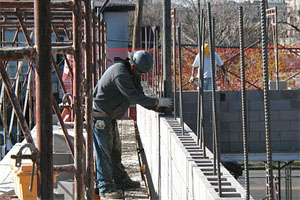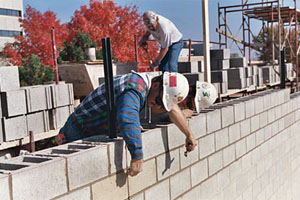Design-build and Masonry Construction
By Jamie Farny

While design-build may be unfamiliar to some people, it’s not a new concept - in fact, it’s quite old. Master builders in ancient Greece used this system to design and construct some of their most monumental structures that are still standing today.
Over time, other delivery systems for construction became common. Today, design-build is not business-as-usual for a majority of North American construction projects, although it is gaining popularity. This article introduces design-build and its benefits, and touches on its potential role for modern masonry construction.
According to the Design-Build Institute of America (DBIA), the basic idea of design-build - and its biggest claimed advantage - is having one entity with full responsibility for taking a project from concept to completion. Responsibility translates to accountability and brings with it the power to control the whole job, including all the important aspects like cost, schedule and quality. The single-entity approach provides the potential to reduce the owner's administrative burdens.
There are three typical approaches to administrative organization of design-build projects:
- Integrated design-build firm, where architects, engineers and builders all work for the same company
- A prime contractor with a subcontractor, where both an architect-engineer (A/E) design firm and a building contractor are involved, but either entity can be the lead
- A joint venture between an A/E and a contractor
The advantages of design-build apply to most, if not all, types of construction. But masonry construction, in particular, provides a good fit with design-build. Outlined below are several reasons why the two are suited to each other.

It's been said that masonry follows a slower construction path because it is laid by hand, one piece at a time. Whether this perception of timing is true is a matter of debate, but what can be said is that a majority of masonry walls are made from materials that are in stock and ready for immediate delivery. Design-build, primarily because it allows for the right sharing of knowledge, uses this timing to the advantage of the schedule. No long lead times (for off-site activities) equals early starts, equals faster project completion.
About the Author
Jamie Farny is the Program Manager of Masonry and Special Products for the Portland Cement Association, coordinating research and promotion activities regarding cements for masonry and white cement. He participates on committees on concrete, plastering, mortars, and masonry units of the American Society for Testing and Materials and the American Concrete Institute. He holds a B.S. in Civil Engineering from the Illinois Institute of Technology.
Reprinted with permission. Copyright© 2006, Portland Cement Association Originally published in PCA's August 2006 Masonry E-Briefing. All graphics courtesy of Portland Cement Association.


















